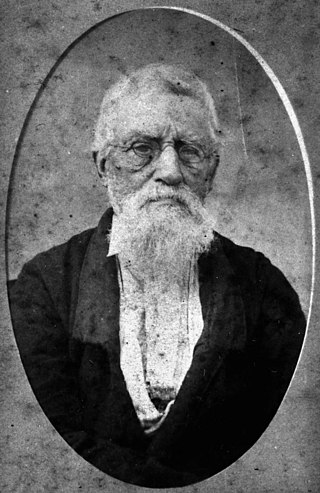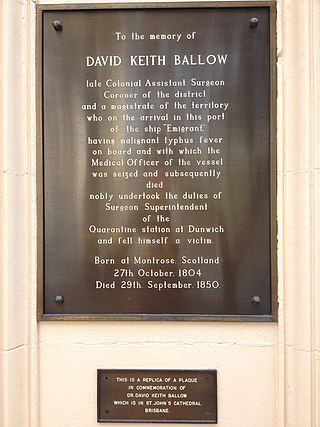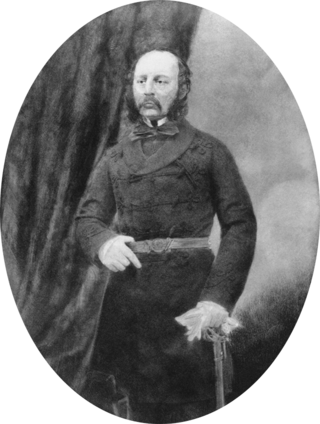
The First Fleet was a fleet of 11 British ships that took the first British colonists and convicts to Australia. It comprised two Royal Navy vessels, three store ships and six convict transports. On 13 May 1787 the fleet under the command of Captain Arthur Phillip, with over 1400 people, left from Portsmouth, England and took a journey of over 24,000 kilometres (15,000 mi) and over 250 days to eventually arrive in Botany Bay, New South Wales, where a penal colony would become the first British settlement in Australia from 20 January 1788.

HMS Sirius was the flagship of the First Fleet, which set out from Portsmouth, England, in 1787 to establish the first European colony in New South Wales, Australia. In 1790, the ship was wrecked on the reef, south east of Kingston Pier, in Slaughter Bay, Norfolk Island.
The history of Australia from 1788 to 1850 covers the early British colonial period of Australia's history. This started with the arrival in 1788 of the First Fleet of British ships at Port Jackson on the lands of the Eora, and the establishment of the penal colony of New South Wales as part of the British Empire. It further covers the European scientific exploration of the continent and the establishment of the other Australian colonies that make up the modern states of Australia.
The following lists events that happened during 1790 in Australia.

Joseph Holt was a United Irish general and leader of a large guerrilla force which fought against British troops in County Wicklow from June–October 1798. He was exiled in 1799 to the colony of New South Wales where he worked as a farm manager for NSW Corp Paymaster Captain William Cox and later returned to Ireland in 1814.

The brown antechinus, also known as Stuart's antechinus and Macleay's marsupial mouse, is a species of small carnivorous marsupial of the family Dasyuridae. The males die after their first breeding season, and the species holds the world record for being the world's smallest semelparous mammal.
Thomas Jamison was a naval surgeon, who was surgeon mate on HMS Sirius as part First Fleet which founded Colony of New South Wales in 1788. He was surgeon at the Norfolk Island settlement, before returning to Sydney and becoming primary surgeon of colony. He was also involved in mercantile dealings which led to the Rum Rebellion, and its overthrow of Governor William Bligh.

Christoph Eipper was a pioneering missionary and Presbyterian minister in Australia.

Richard Brooks, pioneer New South Wales settler, was born in Devon, England, the son of Henry Brooks, a clergyman of Salcombe Regis and Honoria Hall.

Surry, also known as Surrey, was a square-rigged transport ship, which had an especially long career transporting convicts to Australia. In 11 voyages, the most of any convict transport, she brought 2,177 convicts, male and female, and so became one of the best-known of the vessels that visited Australia. In all, she lost 51 men and one woman during her various passages, 46 of the men dying during her first and most notorious voyage in 1814 when she was under the command of James Patterson. The high death toll on her first voyage led to a Board of Enquiry, which blamed neglect by the Master and Surgeon.
Martin Mason was a surgeon, magistrate and commander who is notable as a pioneer settler of Australia, and also as a supporter of Captain Bligh following the 1808 Rebellion at Sydney, New South Wales.

HMS Herald was an Atholl-class 28-gun sixth-rate corvette of the Royal Navy. She was launched in 1822 as HMS Termagant, commissioned in 1824 as HMS Herald and converted to a survey ship in 1845. After serving as a chapel ship from 1861, she was sold for breaking in 1862.
Minerva was a merchantman launched in 1773 in the East Indies. She traded there for more than 20 years before she made three voyages for the British East India Company (EIC). The first EIC voyage was from 1796 to 1798. In 1799, she transported convicts from Ireland to Australia while under charter to the EIC. From Australia she sailed to Bengal, and then back to Britain. She underwent repairs in 1802 and then traveled to St Helena and Bengal for the EIC. She was lost in 1805 or 1806 under circumstances that are currently unclear.

There are 20 known contemporary accounts of the First Fleet made by people sailing in the fleet, including journals and letters. The eleven ships of the fleet, carrying over 1,000 convicts, soldiers and seamen, left England on 13 May 1787 and arrived in Botany Bay between 18 and 20 January 1788 before relocating to Port Jackson to establish the first European settlement in Australia, a penal colony which became Sydney.

Arthur Bowes Smyth was a naval surgeon, who traveled on Lady Penrhyn as a part of the First Fleet that established a penal colony in New South Wales. Smyth kept a diary and documented the natural history he encountered in Australia.

David Keith Ballow (1804–1850) was the Government Medical Officer in Brisbane, Queensland, Australia and the first doctor to establish a private practice in Brisbane.
Lady MacNaghten was an English barque of 553 tons, founded in 1825, which made numerous voyages to Australia, but remembered as the "Fever ship" for her 1837 voyage when one in six passengers died of illness either en route or shortly after arrival.
The Border Police of New South Wales was a frontier policing body introduced by the colonial government of New South Wales with the passing of the Crown Lands Unauthorised Occupation Act 1839.

Lieutenant Colonel Henry Williamson Lugard was a military engineer of the Corps of Royal Engineers. He served as architect and engineer in the construction of military, convict and public works in the Colony of New South Wales and Norfolk Island, military works in New Zealand (1840–1842) and Ireland (1844–1857), and as Commanding Royal Engineer for the China Expedition of 1857, based in Hong Kong.












